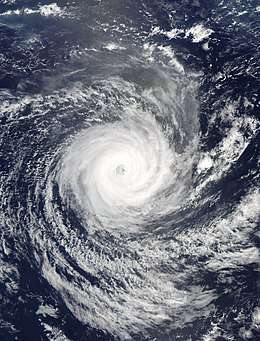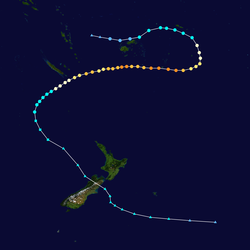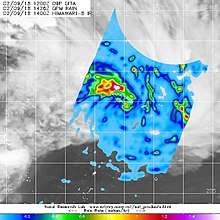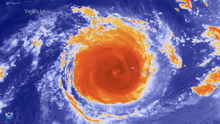Cyclone Gita
Severe Tropical Cyclone Gita was the most intense tropical cyclone to impact Tonga since reliable records began. The second named storm and first major tropical cyclone of the 2017–18 South Pacific cyclone season, Gita originated from a monsoon trough that was active in the South Pacific in early February 2018. First classified as a tropical disturbance on 3 February, the nascent system meandered near Vanuatu for several days with little development. After acquiring a steady east trajectory near Fiji, it organized into a Category 1 tropical cyclone on 9 February near Samoa. Arcing south in a clockwise turn, the system rapidly intensified, and became a severe tropical cyclone on 10 February near Niue.
| Category 5 severe tropical cyclone (Aus scale) | |
|---|---|
| Category 4 tropical cyclone (SSHWS) | |
 Cyclone Gita at peak intensity south of Fiji on 14 February | |
| Formed | 3 February 2018 |
| Dissipated | 22 February 2018 |
| (Extratropical after 19 February) | |
| Highest winds | 10-minute sustained: 205 km/h (125 mph) 1-minute sustained: 230 km/h (145 mph) |
| Lowest pressure | 927 hPa (mbar); 27.37 inHg |
| Fatalities | 1 direct, 1 indirect |
| Damage | $250 million (2018 USD) |
| Areas affected | Vanuatu, Fiji, Wallis and Futuna, Samoa, American Samoa, Niue, Tonga, New Caledonia, Queensland, New Zealand |
| Part of the 2017–18 South Pacific cyclone season | |
Throughout its path in the South Pacific, Cyclone Gita affected multiple island nations and territories. Tonga was the hardest-hit, with severe damage occurring on the islands of Tongatapu and ʻEua; two fatalities and forty-one injuries occurred in the kingdom. At least 171 homes were destroyed and more than 1,100 suffered damage. Violent winds destroyed homes and left the two islands largely without power. Torrential rains and damaging winds caused widespread disruptions in Samoa and American Samoa, prompting emergency declarations in both. Outlying islands in the Fijian Lau Islands were significantly affected, particularly Ono-i-Lau and Vatoa. Wallis and Futuna, Niue, and Vanuatu were also affected, but impacts in those areas were minor. Total damages from Gita are estimated at approximately US$250 million.[1]
Meteorological history

On 3 February, the Fiji Meteorological Service (FMS) started to monitor Tropical Disturbance 07F, which had developed within a trough of low pressure, about 435 km (270 mi) to the southeast of Honiara in the Solomon Islands.[2][3] The system was poorly organized and was located along an upper-level ridge of high pressure, in an area of high vertical wind shear.[3] Over the next couple of days, the system moved erratically near northern Vanuatu and remained poorly organized, with atmospheric convection located to the south of the low-level circulation center.[4] The system subsequently started to move south-eastwards, towards the Fijian Islands and a favorable environment for further development, on 5 February.[5] The system subsequently passed near the island nation during 8 February, where it developed into a tropical depression and started to move north-eastwards towards the Samoan Islands.[6][7] During 9 February, the United States Joint Typhoon Warning Center (JTWC) initiated advisories on the system and designated it as Tropical Cyclone 09P, after an ASCAT image showed that it had winds of 65–75 km/h (40–45 mph) in its northern semicircle.[8] The FMS subsequently named the system Tropical Cyclone Gita early, after the United States National Weather Service Weather Forecast Office in Pago Pago requested that the system be named early for warning and humanitarian reasons.[9]
After Gita was named, a prolonged period of rapid intensification ensued as it quickly intensified into a Category 1 tropical cyclone on the Australian tropical cyclone intensity scale, before it passed within 100 km (60 mi) of Samoa and American Samoa. After moving past the Samoan Islands, Gita turned southeast, then southwards, under the influence of a near-equatorial ridge to the northeast.[10] On 10 February, Gita rapidly intensified to a category 3 severe tropical cyclone on the Australian scale[11] while traversing anomalously warm sea surface temperatures of between 28–29 °C (82–84 °F).[12] On 11 February, Gita continued to intensify into a category 4 severe tropical cyclone.[13] At the same time, Gita turned westward under the influence of a subtropical ridge to the south.[10] At approximately 10:00 UTC (23:00 TOT) on 11 February, the cyclone passed about 30 km (20 mi) south of Tongatapu near its peak intensity, as a powerful Category 5 cyclone on the Australian Scale; the RSMC Nadi-based Australian scale and the JTWC-used Saffir–Simpson scale, with maximum 10-minute sustained winds of 205 km/h (125 mph). At the same time, the Joint Typhoon Warning Center estimated peak 1-minute sustained winds at 230 km/h (145 mph).[14] This made Gita the strongest cyclone to strike Tonga in its recorded history.[15]
Preparations and impact
Gita impacted the Pacific island nations of Vanuatu, Fiji, Wallis and Futuna, Samoa, American Samoa, Niue and Tonga, with the most significant damage being reported in the Samoan Islands and Tonga. As Gita's precursor tropical disturbance impacted Vanuatu's Torba province during 6 February, the Vanuatu Meteorology and Geohazards Department warned that heavy rainfall, thunder and lightning would impact the area and advised people to take extra precautions.[16] Between 8 and 9 February, the system brought strong winds and heavy rain to Wallis and Futuna. Some power outages were reported on Wallis, though overall effects were negligible.[17] During the cyclone's westward turn, it brought significant winds to Niue; however, no damage occurred.[18]
Samoa

Gita brought torrential rain to parts of Samoa on 8–9 February.[19] Hardest hit were areas in and around Apia where more than 350 mm (14 in) of rain fell during the overnight hours.[20] Multiple rivers in the city burst their banks and inundated homes.[21] At least 233 people sought refuge in emergency shelters.[19] Landslides and flooding rendered many roads impassable.[22] Communications were briefly lost with the southern coast of Upolu.[21] A state of disaster was declared for the nation on 10 February.[21] Damage to the power grid reached $10 million.[23]
American Samoa
In the two days preceding Gita's arrival, an associated monsoon trough produced significant rains, reaching 432 mm (17.0 in) across parts of American Samoa.[17] Multiple streams flooded and prompted evacuations in Malaeloa village. Landslides were reported in Avau, Amanave, and Poloa.[24] Cyclone Gita reached American Samoa on 9 February, bringing heavy rains and strong winds; homes were heavily damaged in the villages of Nu'uuli, Tafuna, and throughout the rest of Tutuila.[25] High winds tore roofs of structures and downed trees and power lines.[26] Approximately 90 percent of Tutuila was left without power and water.[27] The local National Weather Service office in Pago Pago lost power; the Honolulu, Hawaii, office issued forecasts in the interim.[26] Rainfall in Pago Pago exceeded 155 mm (6 in).[20] More than 800 people were displaced from their homes across the territory.[26] Pago Pago International Airport suspended operations for the duration of the storm.[28] Inrastructural damage across the territory was about US$7 million,[29] with an insurance loss of US$18.6 million.[30]
A Coast Guard AC-130 conducted aerial surveys of the territory and a small group of Federal Emergency Management Agency (FEMA) personnel were deployed.[28] United States President Donald Trump declared a state of emergency for American Samoa on 11 February.[31] Health officials advised residents to boil water amid an enhanced risk of dengue fever.[26]
Tonga

Prior to and during the cyclone, approximately 5,700 residents sought refuge in public shelters.[32][33] Power was turned off prior to the storm's arrival.[33] Striking Tonga on 12 February, Cyclone Gita brought destructive winds to the capital island of Tongatapu.[15] Initial surveys across the island revealed 119 homes destroyed and another 1,131 damaged,[34] primarily in Nukuʻalofa.[35] Many areas were left without water and power.[15] Many structures lost their roof during the height of the storm.[32] Older structures suffered the greatest damage, including the Tongan Parliament building, built more than 100 years ago, which was flattened by the storm.[32][33] Fuaʻamotu International Airport sustained damage, along with the domestic terminal, prompting officials to keep the airport closed. Across Tongatapu, 3 people suffered major injuries while another 30 experienced minor injuries.[36] An elderly woman died while trying to find shelter after her home was destroyed.[37] One person died from a heart attack potentially related to the storm in Fuaʻamotu.[36]
On the neighboring island of ʻEua, the storm knocked out power to all residents and caused extensive damage. Similar to Tongatapu, older structures suffered severe damage while newer buildings fared well. Crops were largely destroyed.[36] Fifty-two homes were completely destroyed on the island; eight people suffered injury, including one severe.[34] Total damage were estimated at T$356.1 million (US$164.1 million),[38] including a NZ$20 million (US$14.5 million) damage to the power grid.[39]
Immediately following the storm, a curfew was imposed for all of Tonga. Personnel from His Majesty's Armed Forces rescued people during the storm and began clearing roads at daybreak on 13 February. National Emergency Management Office spokesman Graham Kenna called the storm "the worst situation [he has] been in" during his 30-year career.[36] MP Lord Fusituʻa described the impact as the worst since at least Cyclone Isaac in 1982.[37] India provided US$500,000 humanitarian aid to Tonga under UNOSSF. On 13 February, Australia provided A$350,000 (US$275,000) in emergency supplies via the Royal Australian Air Force (RAAF) to assist more than 2,000 people. Australia also sent humanitarian supplies to the Tongan Red Cross. Two civilian humanitarian specialists were deployed to assist Tonga's National Emergency Management Office. A medical expert also provided assistance to assess health infrastructure.[40] New Zealand provided NZ$750,000 (US$544,000) in assistance.[33]
Fiji
On 13 February, the center of Gita passed roughly 60 km (37 mi) south of Ono-i-Lau in the Lau Islands of Fiji.[41] Observations from the island revealed peak sustained winds of 126 km/h (78 mph) with gusts to 156 km/h (97 mph).[42] Flooding from tidal surge preceded the core of the cyclone by several hours.[43] Structural damage was reported in Doi Village, including one home that lost its roof.[44] Communications with Ono-i-Lai and nearby Vatoa were disrupted for roughly a day.[45][35] Across both islands, 10 homes were destroyed and 26 more sustained damage.[46] Many structures sustained roof damage and crops were devastated.[35] Local leaders on Ono-i-Lau called the storm the "worst in living memory".[47] Damage to the nation were at FJ$1.23 million (US$606,000).[48]
New Caledonia
In advance of the storm, most tourists visiting the Isle of Pines, southeast Grande Terre, were evacuated to Nouméa; however, many stayed to ride out the storm. Municipal buildings were opened to the public as shelters. All businesses suspended operations on 16 February.[49]
New Zealand
As Cyclone Gita threatened to hit New Zealand as a strong ex-tropical cyclone, New Zealand's MetService issued heavy rain warnings and strong wind warnings covering a wide expanse of the country.[50][51] Campers, hikers, and boaters in the Marlborough Sounds were told to evacuate, and residents there were warned that communications could be cut off by the storm.[52] Several schools in the region of Nelson were closed,[50] while in the West Coast, schools in the districts of Buller and Grey were closed.[53] Air New Zealand cancelled a number of flights on 20 February.[54]
As Gita bore down on the South Island, bringing floods and strong winds, a state of emergency was eventually declared on 20 February.[55] Insurance loss across the territory were at least NZ$28 million (US$20.6 million).[56]
References
- Weather, Climate & Catastrophe Insight: 2018 Annual Report (pdf) (Report). Aon Benfield. 22 January 2019. Retrieved 16 May 2020.
- "Rain continues and heavy rain warning remains" (PDF) (Press release). Fiji Meteorological Service. 3 February 2018. Retrieved 14 February 2018.
- RSMC Nadi — Tropical Cyclone Centre (3 February 2018). "Tropical Disturbance Summary February 3, 2018 09z". Fiji Meteorological Service. Archived from the original on 26 December 2012. Retrieved 12 February 2018.
- RSMC Nadi — Tropical Cyclone Centre (5 February 2018). "Tropical Disturbance Summary February 5, 2018 09z". Fiji Meteorological Service. Archived from the original on 26 December 2012. Retrieved 12 February 2018.
- "TD08F remains slow moving" (PDF) (Press release). Fiji Meteorological Service. 5 February 2018. Retrieved 14 February 2018.
- "Heavy rain and strong winds to ease as TD07F moves away" (PDF) (Press release). Fiji Meteorological Service. 8 February 2018. Retrieved 14 February 2018.
- RSMC Nadi — Tropical Cyclone Centre (8 February 2018). "Tropical Disturbance Advisory Numver A1". Fiji Meteorological Service. Archived from the original on 8 February 2018. Retrieved 14 February 2018.
- Joint Typhoon Warning Center (9 February 2018). "Tropical Cyclone Warning". Pearl Harbor HI: Government of the United States. Archived from the original on 9 February 2018. Retrieved 14 February 2018.
- RSMC Nadi — Tropical Cyclone Centre (9 February 2018). "Tropical Disturbance Advisory February 9, 2018 06z". Fiji Meteorological Service. Archived from the original on 9 February 2018. Retrieved 12 February 2018.
- "Overall Red alert Tropical Cyclone for GITA-18". GDACS. Joint Typhoon Warning Center. Retrieved 13 February 2018.
- "HURRICANE WARNING 017". WebCite. RSMC Nadi. Archived from the original on 10 February 2018. Retrieved 13 February 2018.
- Henson, Bob. "Eyewall of Fearsome Cyclone Gita Churns across Tonga". Weather Underground. Retrieved 13 February 2018.
- "HURRICANE WARNING 024". WebCite. RSMC Nadi. Archived from the original on 11 February 2018. Retrieved 13 February 2018.
- "Tropical Cyclone Gita is a monster Category 4, Nuku'alofa badly battered". Samoa News. Radio New Zealand. Retrieved 13 February 2018.
- Tapaleao, Vaimoana; Dunlop, Ryan (13 February 2018). "Gita's fury: Tropical cyclone hits Tonga and there are now fears for parts of Fiji". New Zealand Herald. Retrieved 13 February 2018.
- Daniel, Brenda (6 February 2018). "Heavy rainfall expected in Torba province". The Vanuatu Independent News Magazine. Archived from the original on 13 February 2018. Retrieved 12 February 2018.
- "Depression heading towards Samoa expected to become cyclone". Radio New Zealand. 9 February 2018. Retrieved 13 February 2018.
- "Niue spared as Cyclone Gita picks up strength". Radio New Zealand. 11 February 2018. Retrieved 13 February 2018.
- "Widespread flooding in Samoa as Cyclone Gita leaves its mark". TVNZ. 9 February 2018. Retrieved 13 February 2018.
- Leister, Eric (13 February 2018). "Tropical Cyclone Gita leaves trail of destruction from American Samoa to Tonga". AccuWeather. Retrieved 13 February 2018.
- "Damage after Cylcone Gita". Samoa News. Radio New Zealand. 10 February 2018. Retrieved 13 February 2018.
- "Samoa assesses damage as Cyclone Gita, now a category 2, strengthens". Radio New Zealand. 10 February 2018. Retrieved 13 February 2018.
- Feagaimaali’i-Luamanu, Joyetter (21 February 2018). "Gita slaps E.P.C. with $10m bill". Retrieved 23 February 2018.
- "Homes evacuated amid flooding in American Samoa". Radio New Zealand. 8 February 2018. Retrieved 13 February 2018.
- Sagapolutele, Fili (11 February 2018). "Red Cross damage assessment info". Samoa News. Retrieved 13 February 2018.
- "Eight hundred still in shelters in American Samoa". Radio New Zealand. 13 February 2018. Retrieved 13 February 2018.
- Sagapolutele, Fili (11 February 2018). "Gov. issues emergency declaration, power and water coming back on". Samoa News. Retrieved 13 February 2018.
- "Tropical storm hits American Samoa with outages, some damage". Honolulu Star-Advertiser. 10 February 2018. Retrieved 13 February 2018.
- "Gita causes US$7m worth of damage to American Samoa's infrastructure". Radio New Zealand. 26 February 2018. Retrieved 26 February 2018.
- "American Samoa to get over $US60 million in Gita aid". Radio New Zealand. 10 August 2018. Retrieved 10 August 2018.
- "President Donald J. Trump Approves American Samoa Emergency Declaration" (Press release). Government of the United States. 11 February 2018. Retrieved 13 February 2018.
- "Tonga parliament building flattened by Cyclone Gita". BBC. 13 February 2018. Retrieved 13 February 2018.
- Mair, John (12 February 2018). "Cyclone wreaks havoc in Tonga's capital, parliament flattened, homes wrecked". Reuters. Archived from the original on 13 February 2018. Retrieved 13 February 2018.
- "Severe injury in 'Eua devastation". Matangi Tonga. 15 February 2018. Retrieved 15 February 2018.
- "Cyclone Gita: Tonga recovery could take months". Radio New Zealand. 14 February 2018. Retrieved 14 February 2018.
- "Cyclone Gita: Water, shelter and food main needs in Tonga". Radio New Zealand. 13 February 2018. Retrieved 13 February 2018.
- "Cyclone Gita: Tonga damage worst in decades". Radio New Zealand. 13 February 2018. Retrieved 13 February 2018.
- "Tonga: Rapid Damage Assessment and Recovery Framework for Tropical Cyclone Gita". Global Facility for Disaster Reduction and Recovery. 2018.
- Gee, Eleanor (22 February 2018). "Gita power bill a massive NZ$20 million". Matangi Tonga. Retrieved 23 February 2018.
- "Australian humanitarian assistance to Tonga". Government of Australia. ReliefWeb. 13 February 2018. Retrieved 13 February 2018.
- Movono, Lice (13 February 2018). "TC Gita: At its closest now". The Fiji Times. Archived from the original on 13 February 2018. Retrieved 13 February 2018.
- Severe TC Gita (Cat4) Passes Just South of Ono (PDF). Fiji Meteorological Services (Report). ReliefWeb. 13 February 2018. Retrieved 13 February 2018.
- Naleba, Mere (13 February 2018). "TC Gita: Tidal surge reported on Ono-i-Lau". The Fiji Times. Archived from the original on 13 February 2018. Retrieved 13 February 2018.
- Naleba, Mere (13 February 2018). "TC Gita: Rooftop gone at Doi". The Fiji Times. Archived from the original on 13 February 2018. Retrieved 13 February 2018.
- "Cyclone Gita moves away from Fiji but communication lost with islands in Southern Lau group". TVNZ. 13 February 2018. Retrieved 13 February 2018.
- Maika Bolatiki (15 February 2018). "10 Houses Destroyed, 26 Partly Damaged On Islands". Fiji Sun. Retrieved 15 February 2018.
- "Cyclone Gita 'worst in living memory' on Fiji's Ono-i-Lau". Radio New Zealand. 14 February 2018. Retrieved 14 February 2018.
- "TC Gita damage cost stands at $1.23m". Fiji Broadcasting Corporation. 19 March 2018. Retrieved 19 March 2018.
- "Nouvelle-Calédonie: Alerte cyclonique maximale à l'île des Pins" (in French). 20 minutes. Agence France-Presse. 16 February 2018. Retrieved 16 February 2018.
- "Preparing for Cyclone Gita: What you need to know". Stuff.co.nz. 19 February 2018. Retrieved 19 February 2018.
- Godfrey, Kara (19 February 2018). "Cyclone Gita: Travel warning as category 5 tropical storm threatens New Zealand flights". Express.co.uk. Retrieved 20 February 2018.
- Lewis, Oliver; Daly, Michael (19 February 2018). "Cyclone Gita: New Zealand braces for storm, huge seas expected". Stuff.co.nz. Retrieved 19 February 2018.
- "West Coast residents battening down as Cyclone Gita eyes New Zealand with 200mm of rain, huge waves and 140km/h winds". Television New Zealand. 19 February 2018. Retrieved 19 February 2018.
- "Former Cyclone Gita: Air New Zealand cancels all Wellington flights". Stuff. Retrieved 20 February 2018.
- "Gita: State of emergency as storm hits New Zealand". British Broadcasting Corporation. 20 February 2018. Retrieved 20 February 2018.
- "Insurers pay out $93 million this year so far". Radio New Zealand. 10 April 2018. Retrieved 10 April 2018.
External links
| Wikimedia Commons has media related to Cyclone Gita. |
- World Meteorological Organization
- Australian Bureau of Meteorology
- Fiji Meteorological Service
- New Zealand MetService
- Joint Typhoon Warning Center
